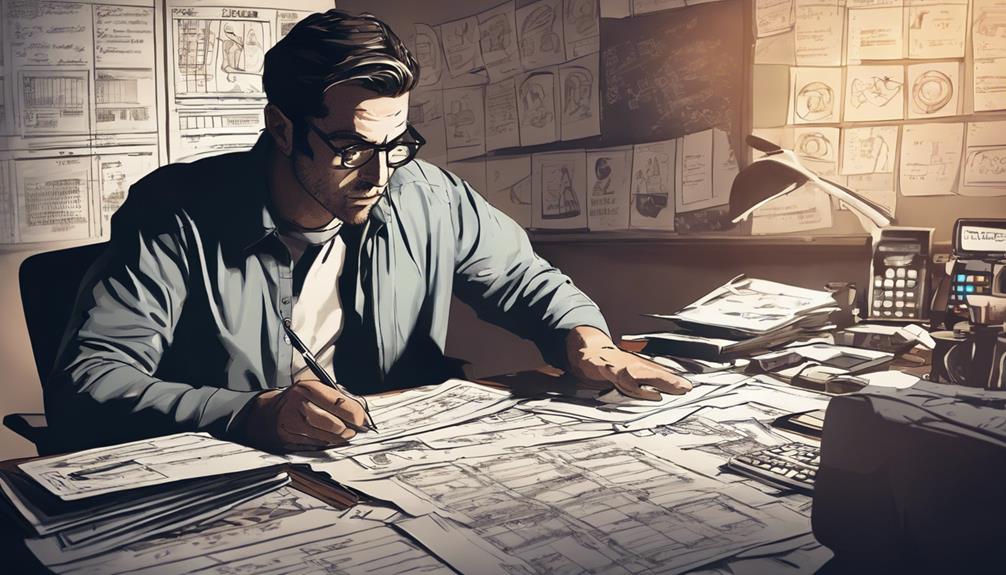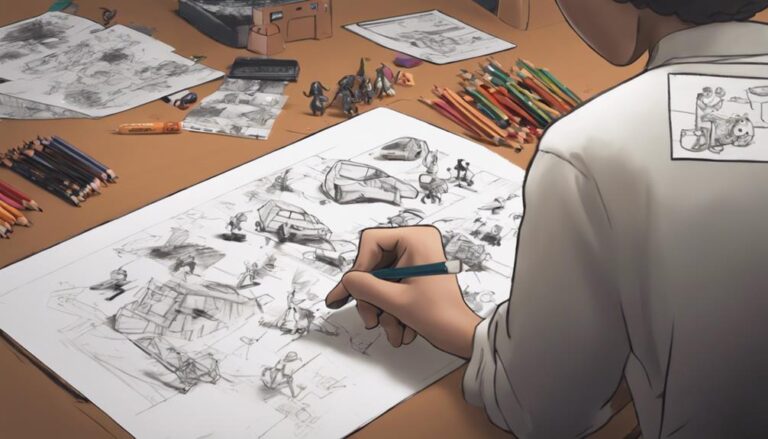Planning an Animation Video Production Budget Effectively
As you set out on planning your animation video production, you're likely wondering how to allocate your budget effectively to bring your vision to life. You're not alone – many producers struggle to balance creative ambitions with financial realities. By identifying your project's scope, goals, and target audience, you'll be better equipped to make informed decisions about where to invest your resources. But that's just the starting point. You still need to navigate the complex landscape of production costs, timeline expectations, and resource allocation. Where will you choose to prioritize your spending, and how will you mitigate unexpected expenses?
Key Takeaways
- Identify project objectives, target audience, and desired outcomes to establish a solid foundation for budget planning.
- Estimate costs by considering script development, storyboard creation, animation style, and production timeline.
- Allocate resources efficiently by breaking down production into smaller tasks and prioritizing essential expenses.
- Set a realistic contingency fund (10-20% of the total budget) to prepare for unexpected expenses and stay on track.
- Regularly review and adjust the budget to ensure it aligns with project needs and stays within allocated funds.
Defining Project Scope and Goals
Define the project's scope and goals by identifying the key objectives, target audience, and desired outcomes to guarantee everyone involved is on the same page from the start.
This vital step confirms you create an animation video that meets your needs and resonates with your audience. Begin by outlining your project objectives, such as increasing brand awareness, explaining a complex concept, or driving sales.
Next, identify your target audience, considering their demographics, interests, and pain points. This will help you tailor your message and visual style to effectively engage them.
Now, engage in creative visioning to visualize the final product. Imagine the tone, style, and narrative that will bring your objectives to life.
Consider the length, format, and distribution channels for your animation video. By clarifying these essential details, you'll establish a solid foundation for your project, enabling you to stay focused, prioritize resources, and make informed decisions throughout the production process.
With a well-defined scope and goals, you'll be well on your way to creating an impactful animation video that achieves your desired outcomes.
Understanding Production Costs
Estimating the cost of your animation video production requires a clear understanding of the various components that drive expenses, from script development and storyboard creation to animation style and voiceover talent selection.
You need to ponder the complexity of your animation techniques, such as 2D, 3D, or stop-motion, as they substantially impact production costs.
The production timeline plays a vital role in determining expenses, as rush projects or tight deadlines may require overtime or additional resources.
You'll also need to factor in the costs of voiceover talent, music licensing, and sound design.
Moreover, ponder the number of revisions you're willing to allow, as excessive changes can drive up costs.
Optimizing your budget is vital to identify areas where you can cut costs without compromising the quality of your animation.
Setting Realistic Timeline Expectations
As you plan your animation video production, it's vital to set realistic timeline expectations to guarantee your project stays on track.
You'll need to define the project scope, set realistic deadlines, and align tasks according to priority to create a feasible schedule.
Project Scope Definition
Determine the scope of your animation video project by identifying the essential elements that need to be included, and prioritize them based on importance and complexity to guarantee a realistic timeline. This is vital in setting project boundaries, which will help you avoid scope creep – a common issue where the project's requirements keep expanding, leading to delays and budget overruns.
To define your project scope, ask yourself what's absolutely necessary for your animation video to achieve its goals.
Identify the must-haves, nice-to-haves, and nice-to-have-but-not-essential elements. Be honest with yourself – if something can be cut without compromising the project's objectives, then it's not essential.
Realistic Deadlines Setting
You'll need to set realistic deadlines by reversing-engineering your project timeline, working backward from the final delivery date to guarantee each milestone is achievable and aligned with your resources.
This approach helps you identify potential bottlenecks and allocate sufficient time for each task.
Be sure to include time buffers between milestones to account for unexpected delays or setbacks.
These buffers will give you breathing room to adjust your timeline without compromising the project's overall quality.
When setting deadlines, prioritize milestone flexibility.
Don't overcommit to rigid timelines that can lead to burnout or rushed work.
Instead, build in flexibility to accommodate changes or unexpected challenges.
This will enable you to adapt to new requirements or shifts in project scope without derailing the entire production.
Task Priority Alignment
Frequently, task priority misalignment can derail even the most meticulously planned animation video production, which is why proper task allocation based on their urgency and impact on the project timeline is crucial.
You need to identify the most critical tasks that can make or break your project timeline.
Once you've done that, cluster similar tasks together to optimize your resources.
This task clustering approach enables you to allocate your resources more efficiently, ensuring that you're focusing on the most critical aspects of your animation video production.
Allocating Resources Wisely
Break down your animation video production into smaller tasks to identify areas where you can allocate your resources efficiently, guaranteeing that every dollar and hour counts.
This exercise helps you pinpoint where to concentrate your efforts and make the most of your budget. By doing so, you'll be able to optimize your resource allocation and make the most of your available funds.
Some key areas to focus on when allocating resources wisely:
Storyboarding and concept development: Verify you have a solid script and storyboard to guide your production, saving you time and resources in the long run.
Talent acquisition and management: Hire the right team members and freelancers, and manage their workload effectively to minimize costs and maximize output.
Equipment and software: Invest in the necessary tools and software to produce high-quality animation, but avoid unnecessary expenses.
Project timeline and milestones: Establish a realistic project schedule and set achievable milestones to keep your production on track and within budget.
Prioritizing Spending Categories
To effectively manage your animation video production budget, categorize your expenses into needs, wants, and nice-to-haves, and prioritize your spending accordingly. This will help you allocate your resources efficiently and make the most of your budget.
Needs are essential expenses, such as scriptwriting, storyboarding, and animation production. These costs are non-negotiable and should be allocated a significant portion of your budget.
Wants are expenses that enhance the quality of your animation, such as 3D modeling, special effects, or professional voiceovers. While they're not essential, they can elevate your animation's overall quality.
Nice-to-haves are expenses that are luxurious but not necessary, such as high-end software or hiring a celebrity voice actor.
When prioritizing your spending, allocate the largest portion of your budget to needs, followed by wants, and finally, nice-to-haves. This cost categorization will guarantee you're spending your budget on the most critical aspects of your animation video production.
Estimating Animation Style Costs
You'll need to estimate the costs associated with your chosen animation style, as different styles can substantially impact your budget. The style you choose will influence the complexity of your project, and subsequently, the costs.
Some key factors to weigh when estimating animation style costs include:
- Visual complexity: The more intricate and detailed your animation is, the more time and resources it will require, increasing costs.
- Style consistency: Maintaining consistency in your animation style throughout the video will require more planning and attention to detail, adding to the overall cost.
- Character design: The number and complexity of characters in your animation will impact costs, as will the need for character development and design.
- Background and set design: The level of detail and realism in your backgrounds and sets will also influence costs, with more complex designs requiring more time and resources.
Budgeting for Sound Design Elements
When budgeting for sound design elements in your animation video production, you'll need to ponder the costs of music and sound effects (SFX) that will enhance the overall audio experience.
You'll also need to factor in the fees of a voiceover artist, if you're planning to include a narrative or dialogue in your animation.
Music and SFX Costs
Your animation video's soundtrack, comprising music and sound effects (SFX), can eat up a significant chunk of your overall budget. To avoid overspending, vital planning of your music and SFX costs is paramount.
When it comes to music, you have two options: original composition or music licensing.
Original composition involves budgeting for composer fees, which can range from $1,000 to $10,000 or more, depending on the complexity and length of the piece.
Music licensing is a more affordable option, with prices starting from $50 to $500 or more per track, depending on the license type and duration of use.
You'll also need to budget for Sound Effects (SFX), such as sound design elements, Foley, and ambiance. These costs can add up quickly, so pivotal prioritization of your SFX needs and allocation of your budget accordingly is necessary.
Voiceover Artist Fees
Securing a talented voiceover artist can substantially enhance your animation video's narrative, but it comes at a cost that you'll need to factor into your overall budget.
When planning for voiceover artist fees, verifying industry standards is crucial to determine a fair rate for your project. Voiceover rates vary depending on factors such as the artist's experience, the type of project, and the length of the script.
On average, voiceover artists charge between $200 to $1,000 per hour of recorded audio. For a typical animation video, you can expect to pay around $500 to $2,000 for a high-quality voiceover.
However, these rates can add up quickly, especially if you need multiple voices or a large amount of narration. To get the best value for your money, consider hiring a voiceover artist who offers a package deal or a flat rate for your entire project.
Be sure to also factor in additional costs, such as editing and mixing, to guarantee you have a realistic budget for your animation video's sound design elements. By doing your research and planning accordingly, you can find a talented voiceover artist who fits your budget and brings your animation video to life.
Considering Distribution Platform Fees
You'll need to factor in the fees associated with the distribution platforms you plan to use, as they can eat into your animation video's profit margins. When developing your distribution strategies, it's crucial to contemplate the costs involved in getting your video in front of your target audience.
Video hosting platforms may charge fees for premium features, such as advanced analytics or ad-free viewing. YouTube, Vimeo, and other video hosting platforms offer different pricing tiers and features.
Advertising platforms charge fees based on ad impressions, clicks, or conversions. Google Ads, Facebook Ads, and other advertising platforms have varying pricing models and ad formats.
OTT platforms like Netflix, Hulu, or Amazon Prime Video may charge licensing fees for hosting your content. These fees can vary depending on the platform, content type, and audience reach.
Social media platforms may charge fees for sponsored content or promoted posts. Some social media platforms, like LinkedIn or Facebook, offer paid advertising options to increase your video's visibility.
Managing Contingency Funds
By setting aside a contingency fund, you're preparing for unexpected expenses that can derail your animation video production, such as last-minute script changes or equipment malfunctions. This fund serves as a safety net, ensuring that your project stays on track despite unforeseen costs.
When allocating your contingency fund, consider the complexity of your project and the potential risks involved. A general rule of thumb is to set aside 10-20% of your total budget for contingency allocation. This amount will provide a comfortable fund reserve to cover unexpected expenses without breaking the bank.
It's essential to regularly review and update your contingency fund as your project progresses. Identify areas where you can reallocate funds or make adjustments to reduce costs. Remember, your contingency fund is meant to be a reserve, not a slush fund.
Frequently Asked Questions
How Do I Balance Creative Vision With Budget Constraints Effectively?
You balance creative vision with budget constraints by prioritizing must-haves, negotiating with vendors, and embracing creative flexibility within budget realities, ensuring your artistic goals align with financial limitations.
Can I Reuse Existing Branding Assets in My Animation Video?
You can definitely reuse existing branding assets in your animation video, but first, review your Brand Guidelines to guarantee consistency, then take stock of your Asset Inventory to identify reusable elements that align with your vision.
What Is the Ideal Team Size for an Animation Video Production?
You'll need a team of 5-10 people for a typical animation video production, considering team dynamics and freelance management. This size allows for efficient collaboration, specialized skills, and adaptability to project demands.
How Do I Handle Last-Minute Changes to the Project Scope?
When handling last-minute changes, you'll need a solid change management process to avoid scope creep. Prioritize, assess, and document each change, then negotiate with stakeholders to guarantee realistic timelines and budgets.
Are There Any Tax Incentives for Animation Video Production Costs?
You'll be happy to know that yes, you can capitalize on tax credit benefits and film subsidy opportunities to offset animation video production costs, potentially saving thousands – research and claim them in your jurisdiction.
Conclusion
You've got a solid plan in place to tackle your animation video production budget.
Remember to regularly review and adjust your budget to guarantee you're on track.
Be prepared to make tough decisions if unexpected expenses arise, and don't hesitate to reallocate resources as needed.
By following these guidelines, you'll be well-equipped to bring your vision to life while staying within budget.
Stay focused, and you'll be celebrating a successful project in no time.






